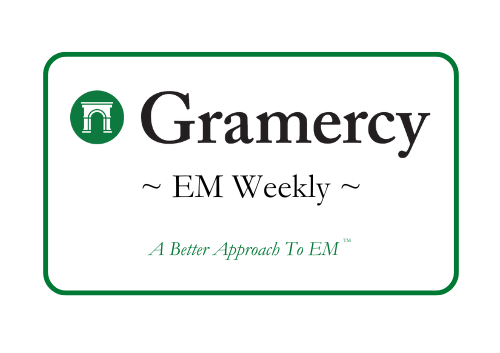Contents
Market Overview
Macro Update
Markets found further relief this week as signs emerged that more pragmatic voices within the Trump Administration may be gaining influence. This shift was most evident in Treasury Secretary Scott Bessent’s measured tone at the IMF Spring Meetings in Washington, D.C., where his comments suggested a move away from the more confrontational elements of the administration’s early April “Rose Garden” trade policy framework. Investors appeared reassured by signals that the U.S. is actively pursuing negotiated outcomes, including renewed outreach to China, in an effort to avoid a broader and more disruptive global trade conflict.
Investor sentiment was further buoyed by solid earnings from key technology companies and a strong jobs report. Quarterly results from Microsoft and Meta helped propel U.S. equity indexes higher, with several benchmarks recovering fully from April’s losses following the tariff shock post-Liberation Day. Indeed, the nine straight sessions of gains was the longest streak in 21 years. A separate report that the administration is considering easing restrictions on Nvidia’s exports to the UAE also contributed to a rally in semiconductor stocks. At the same time, not all corporate news was positive—General Motors trimmed its full-year profit outlook, citing headwinds from auto tariffs, while McDonald’s disappointed as its Q1 sales missed expectations.
Apple and Amazon’s earnings were particularly closely watched for clues on tariff related disruptions given the companies’ supply chain exposure to Asia. Apple warned its costs are likely to jump by $900 million in 2Q on the back of tariffs, while Amazon reduced its operating profit projections, citing material impact from tariffs, foreign-exchange fluctuations and recession concerns.
Turning to macroeconomic indicators, this week’s data continued to suggest a moderating, yet still resilient, U.S. economy—for now. The Conference Board’s consumer confidence index fell for the fifth consecutive month, reaching 86 in April—the lowest level since the pandemic. The first estimate of Q1 GDP showed a contraction of 0.3% annualized, weaker than consensus and a sharp reversal from Q4’s 2.4% expansion. However, the decline was largely attributed to front-loaded imports ahead of expected tariff changes. Meanwhile, the ISM manufacturing index edged further into contractionary territory at 48.7. Price pressures at the input level rose modestly but undershot expectations. Initial jobless claims rose to 241,000—higher than recent readings but still within a historically normal range.
The March core PCE deflator—the Fed’s preferred inflation gauge—was unchanged month-over-month (vs. expectations of +0.1%), despite robust personal spending and consumption figures. While March data has limited forward relevance given subsequent policy developments, it reinforces the view that the U.S. economy had solid underlying momentum heading into the post-Rose Garden policy regime.
Non-farm payrolls signalled notable resilience in the U.S. economy and labor market through April, potentially diminishing market fears about a near-term recession. April’s job creation data came at 177,000, comfortably beating consensus expectations of 138,000. However, the March number was revised significantly lower to 185,000 from 228,000 initially reported. The unemployment rate stayed steady at 4.2% in April, while average hourly earnings came in at 0.2% month-over-month and 3.8% year-over-year, below expectations of 0.3% and 3.9%, respectively.
Abroad, April’s Chinese PMI data were mixed. The Caixin manufacturing index slipped to 50.4 but still came in above expectations. In Europe, inflation expectations picked up slightly, with the ECB’s one- and three-year gauges rising to 2.9% and 2.5%, respectively. Preliminary Eurozone GDP growth for Q1 came in stronger than expected at 1.2% year-over-year and 0.4% quarter-over-quarter, reinforcing the theme of an uneven but ongoing global recovery.
Preliminary April CPI numbers for the eurozone surprised on the upside: 0.6% vs. 0.5% month-over-month and 2.7% vs 2.5% core year-over-year. Nevertheless, a June rate cut by the ECB remains likely given expected disinflationary news in Europe on the horizon, but ECB policy path for the second half of 2025 could become more uncertain.
In commodity and currency markets, oil prices remained under pressure, with Brent once again testing the $60/barrel threshold—an expression of persistent concerns around global growth and demand elasticity. U.S. Treasury yields were range-bound, with the 10-year settling near 4.30%. The dollar recovered somewhat but remains under pressure. While the euro pulled back toward 1.13, it remains relatively strong by historical standards. The yen weakened to ~145 per dollar following a more dovish-than-expected message from the Bank of Japan, which extended its projected timeline for meeting its inflation target. Gold, after a strong year-to-date performance, slipped modestly amid a shift away from safe-haven assets.
On the geopolitical front, the U.S. and Ukraine reached a preliminary agreement involving future joint development of Ukraine’s natural resources. While the near-term economic implications are limited, the agreement may help ensure continued U.S. engagement on Ukraine, particularly as the administration seeks to show progress in the still-unresolved conflict. In South Asia, tensions between India and Pakistan escalated following a deadly terrorist attack in Kashmir, with India threatening water supply restrictions—a development that could further destabilize a region prone to periodic flare-ups.
EM Credit Update
Emerging markets performance was mixed this week. Despite some volatility in the U.S. dollar, EM local currency sovereign bonds continued to outperform, delivering a return of +0.5%. EM corporate credit also posted a modest gain of +0.1%, supported by the investment grade segment, which returned +0.3%. In contrast, the high yield segment declined -0.2%, weighed down by weakness in the oil and gas sector. EM corporate spreads remained largely unchanged on the week.
On the sovereign side, external debt underperformed, with the overall EM sovereign index returning -0.2%. As with corporates, the divergence between credit quality segments was notable: Investment grade sovereigns returned +0.4%, while high yield fell -0.7%. Overall sovereign spreads widened by 8bps, driven entirely by a 21bps widening in high yield names, while investment grade spreads were flat. High-beta, oil-linked credits such as Angola, Nigeria, Venezuela, and Ecuador underperformed, reflecting the weakness in oil prices. Pakistan also remained under pressure amid heightened geopolitical tensions with India.
The primary market was more active this week, particularly on the corporate side, where 18 issuers came to market, seeking to lock in funding in a still-uncertain macro environment. On the sovereign side, there were three new deals: Bahrain and Kenya issued in U.S. dollars, while Bulgaria came to market in euros.
The Week Ahead
Next week includes interest rate decisions by the Fed and Bank of England (BoE), general elections in Australia and Singapore and presidential elections in Romania, the start of the Vatican conclave to elect a new pope, as well as a continuous flurry of 1Q earnings reports by global companies. The Fed is expected to hold rates as policymakers continue to gauge the impact of President Donald Trump’s tariffs. Their BoE colleagues are expected to lower the key rate by 25bps to 4.25% in response to increased global economic uncertainty. ECB policymakers begin a two-day informal retreat in Portugal, where they will conduct their first in-depth debate on an ongoing review of their monetary-policy strategy. In other notable events, OPEC+ will meet to discuss production levels, Germany’s parliament is set to confirm Friedrich Merz as chancellor, and Secretary Bessent testifies at a House hearing on U.S. fiscal and economic policy. In Moscow, President Putin is expected to welcome world leaders such as Chinese President Xi Jinping and Brazilian President Luiz Inácio Lula da Silva at celebrations marking Russia Victory Day and the 80th anniversary of the end of World War II. Prominent macro data releases in DM include U.S. ISM services, trade, and jobless claims, eurozone retail sales, Germany factory orders and industrial production, as well as rate decisions in Norway and Sweden. In EM, we have rate decisions in Pakistan, Brazil, Czech Rep, Poland, Malaysia, Peru, and Uganda. CPI data for April will be released in Taiwan, Thailand, Chile, Colombia, Mexico, and Brazil, while markets will see GDP data from Indonesia, Kenya, and the Philippines. China will report the Caixin services PMI, foreign exchange reserves and trade data.
Fixed Income
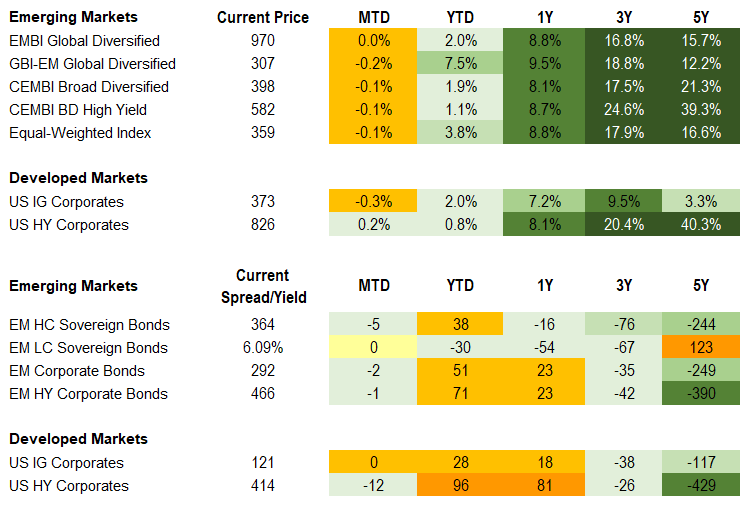
Equities
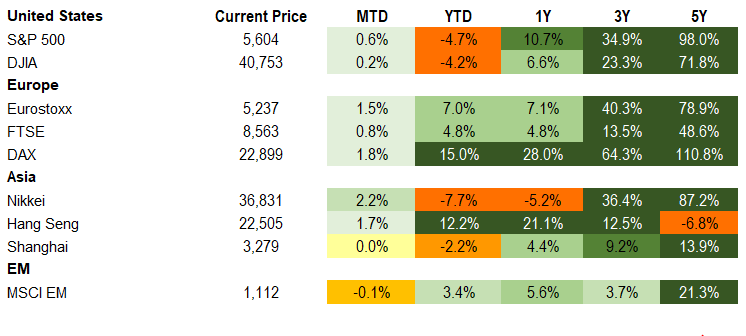
Commodities

Source for data tables: Bloomberg, JPMorgan, Gramercy. EM Fixed Income is represented by the following JPMorgan Indicies: EMBI Global, GBI-EM Global Diversified, CEMBI Broad Diversified and CEMBI Broad High Yield. DM Fixed Income is represented by the JPMorgan JULI Total Return Index and Domestic High Yield Index. Fixed Income, Equity and Commodity data is as of May 2, 2025 (mid-day).
Highlights
Minerals Deal May Extend U.S. Engagement on Ukraine
Event: The U.S. and Ukrainian governments signed a political agreement that could potentially set the stage to jointly exploit Ukraine’s natural resources. Secretary Bessent, who signed the deal for the U.S., said the agreement signals the Trump Administration wants a “peace process centered on a free, sovereign, and prosperous Ukraine.”
Gramercy Comment: The technical framework underpinning the political agreement on the “minerals deal” is yet to be defined, and its economic significance is likely to remain limited in the absence of a broader resolution to the Ukraine-Russia conflict. Notably, some of the more contentious proposals—such as the Trump Administration’s initial push for a $500 billion “repayment” for U.S. aid provided under the Biden Administration—appear to have been set aside. In the near-term, the deal’s primary relevance may lie in providing a mechanism to keep the Trump Administration engaged on the Ukraine issue, even as its earlier ambition of delivering a peace deal within the first one-hundred days in office has not materialized.
Gramercy has consistently held the view that a near-term resolution—or even a sustained freeze—of the conflict was unlikely in 2025. With the administration now seemingly aligning with this assessment, the focus from Kyiv’s perspective shifts toward preserving U.S. support and avoiding any U.S. disengagement or tacit U.S. backing of Russia’s strategic goals. In this context, the minerals agreement may serve as a platform to maintain U.S. involvement, potentially enabling continued intelligence sharing and facilitating indirect military support through third-party transfers of U.S.-origin equipment by European allies. Any such arrangement is likely to provoke a response from Moscow and further attempts to test Ukrainian military vulnerabilities may be expected.
India-Pakistan Tensions Escalate, but Water Threat Is Muted
Event: India threatened to cut Pakistan’s water supply after a terrorist attack in Kashmir killed several Indians and set-off military posturing in the aftermath. India has signaled a military response, to which Pakistan has responded it will react. The U.S. State Department has urged de-escalation. This is the first flare in tensions after the 2021 renewal of a previously frequently broken 2003 ceasefire.
Gramercy Comment: We expect a tit-for-tat escalation between the two nuclear power nations in the near-term but avoidance of deeper deterioration in the conflict which results in war or effective stoppage of water supply under India’s suspension of the Indus Water Treaty. The latter faces near-term complications given lack of dam infrastructure and externalities such as flooding in India, although reservoirs could be drained, mildly reducing near-term agricultural output in Pakistan. The impact over the medium-term could grow, if India expands infrastructure to increase water-storage capacity, and more meaningfully divert water flows. More broadly, Pakistan’s macroeconomic position has improved from a very fragile base under IMF support and lower oil prices, bringing foreign-exchange reserves back to around three months of import cover. In the event of a more protracted conflict, Pakistan’s macroeconomic vulnerabilities could be increasingly strained, particularly if program performance slips or IMF relations erode.
Emerging Markets Technicals
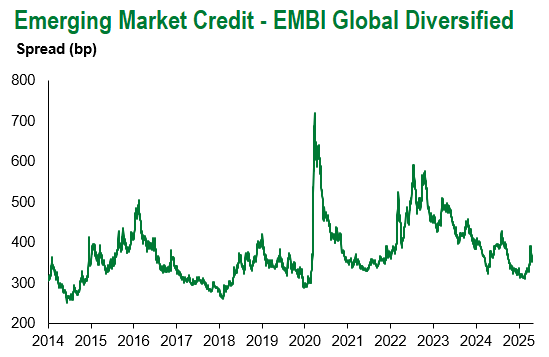
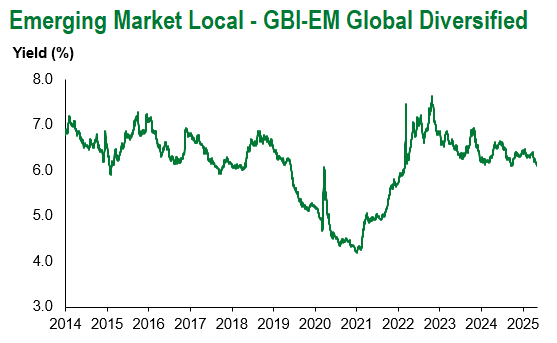
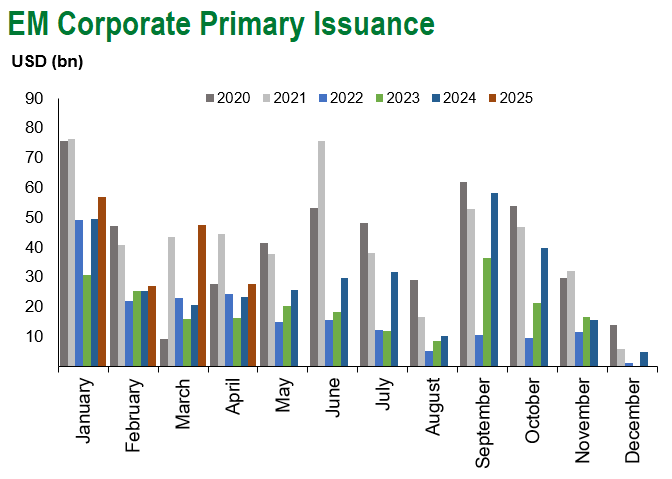
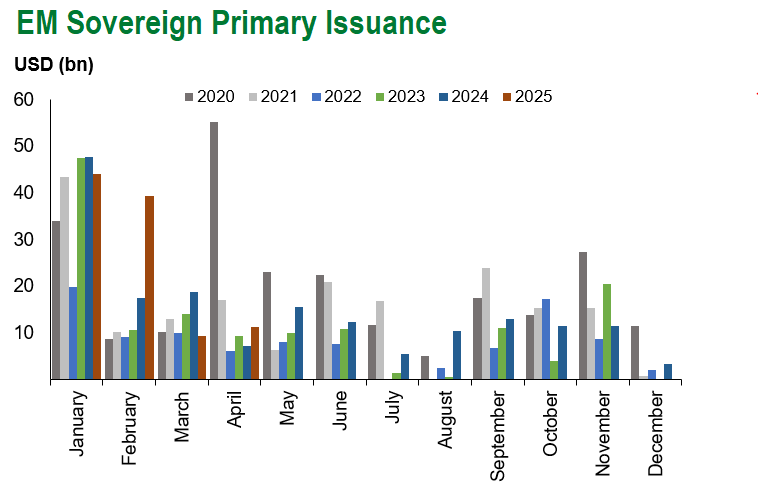
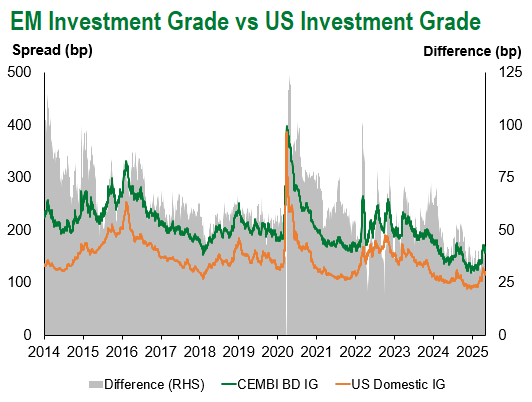
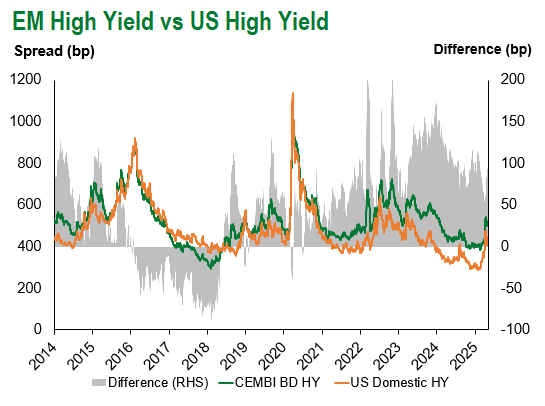
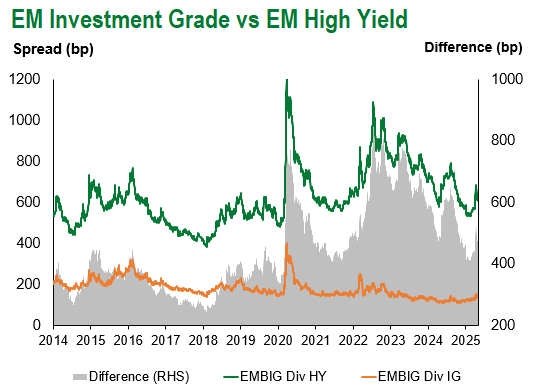
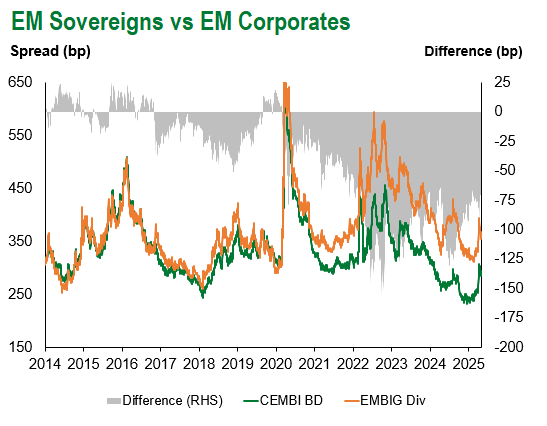
Emerging Markets Flows
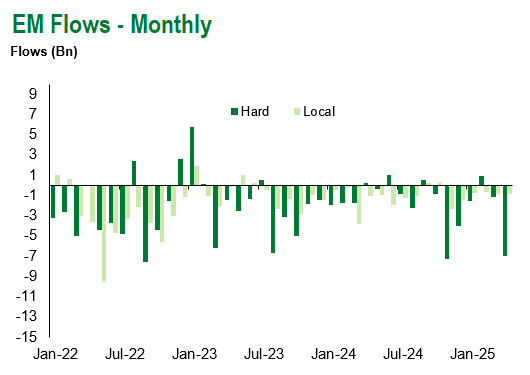
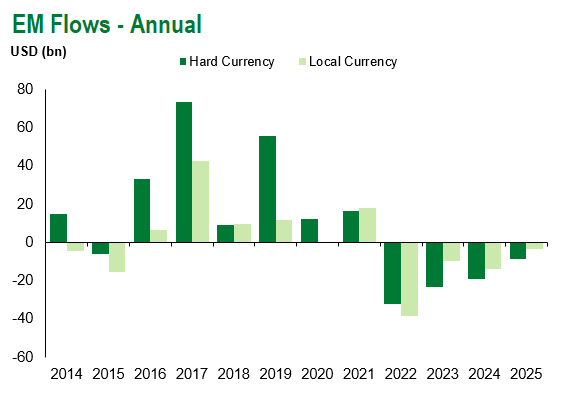
Source for graphs: Bloomberg, JPMorgan, Gramercy. As of May 2, 2025.
For questions, please contact:
Kathryn Exum, CFA ESG, Director, Co-Head of Sovereign Research, [email protected]
Petar Atanasov, Director, Co-Head of Sovereign Research, [email protected]
This document is for informational purposes only. The information presented is not intended to be relied upon as a forecast, research or investment advice, and is not a recommendation, offer or solicitation to buy or sell any securities or to adopt any investment strategy. Gramercy may have current investment positions in the securities or sovereigns mentioned above. The information and opinions contained in this paper are as of the date of initial publication, derived from proprietary and nonproprietary sources deemed by Gramercy to be reliable, are not necessarily all-inclusive and are not guaranteed as to accuracy. This paper may contain “forward-looking” information that is not purely historical in nature. Such information may include, among other things, projections and forecasts. There is no guarantee that any forecasts made will come to pass. Reliance upon information in this paper is at the sole discretion of the reader. You should not rely on this presentation as the basis upon which to make an investment decision. Investment involves risk. There can be no assurance that investment objectives will be achieved. Investors must be prepared to bear the risk of a total loss of their investment. These risks are often heightened for investments in emerging/developing markets or smaller capital markets. International investing involves risks, including risks related to foreign currency, limited liquidity, less government regulation, and the possibility of substantial volatility due to adverse political, economic or other developments. References to any indices are for informational and general comparative purposes only. The performance data of various indices mentioned in this update are updated and released on a periodic basis before finalization. The performance data of various indices presented herein was current as of the date of the presentation. Please refer to data returns of the separate indices if you desire additional or updated information. Indices are unmanaged, and their performance results do not reflect the impact of fees, expenses, or taxes that may be incurred through an investment with Gramercy. Returns for indices assume dividend reinvestment. An investment cannot be made directly in an index. Accordingly, comparing results shown to those of such indices may be of limited use. The information provided herein is neither tax nor legal advice. Investors should speak to their tax professional for specific information regarding their tax situation.
